

As noted, the KAAA consisted of young and old astronomy enthusiasts from the start. In addition to Mr. Ashby, some of the other prominent local amateur astronomers included Hans & Lillian Baldauf, Alfred M. Bryant, Jim Hopkins, Leonard Hayden, Edgar Pashby, William Persons, James Sigler, Louis Stadler, and Dr. Lawrence N. Upjohn. Commercially built telescopes were fairly expensive at the time, so many of the members constructed their own instruments, using surplus optics or grinding their own mirrors.
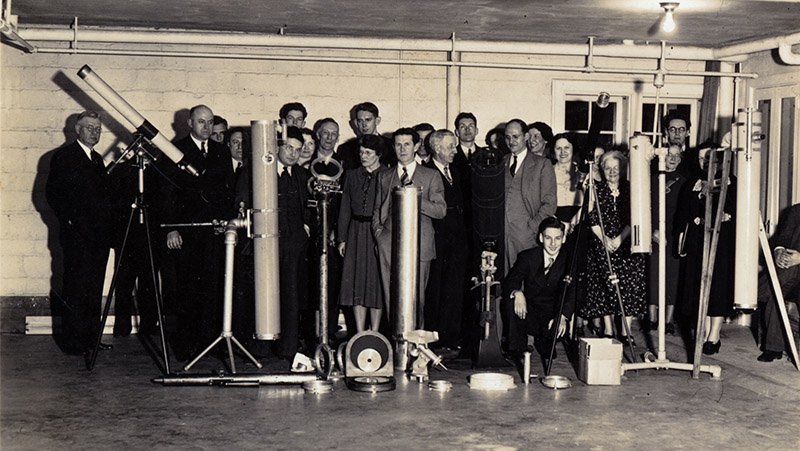
Kalamazoo Amateur Astronomical Association (circa late 1930s)
From left to right: Dr. Lawrence N. Upjohn, unknown man (behind refractor), Leonard Hayden, unknown man (behind Leonard), unknown man (left of reflector), Louis Stadler (front),
Jimmie Sigler, Jennie Hayden, Leonard James Ashby, Nona Ashby, Edgar Pashby (behind Nona), Hans Baldauf (front and center), Shiley? (behind Hans), Alfred Bryant (in profile),
unknown man, Harriet Sigler (partial), Jim Hopkins, Fred Ashby (kneeling), Lillian Baldauf, unknown woman, unknown woman, Gratia Upjohn (dark dress), Bertha Ashby (front),
William Persons, unknown woman (behind telescope), unknown man sitting on far right.
At least two of our members received a fair amount of notoriety for their amateur telescope-making efforts. The Kalamazoo Gazette published an article about Mr. Ashby’s successful effort to grind a 10-inch primary mirror. Both he and his wife, Nona, were featured in The Beginner’s Corner section of the November 1939 issue of Scientific American. Alfred M. Bryant was also the subject of at least two articles. We first learned of Mr. Bryant’s name from Philip Steffey, who joined the KAAA in 1953 at the age of 14 and remained a member until 1960. He wrote an article in which he mentions first joining the KAAA. He described Mr. Bryant “as the patriarch of astronomy in the Kalamazoo area.” This certainly seems to be the case, based on what was found in old newspapers.
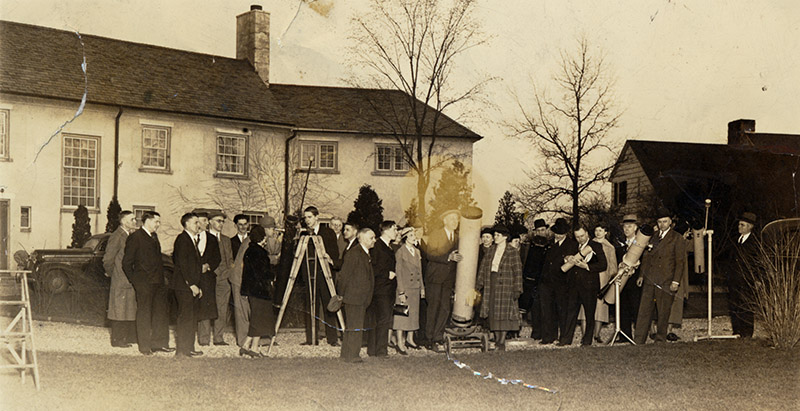
KAAA members gather for an observing session.
The first article found on Mr. Bryant’s telescope-making efforts was in the Detroit Free Press from March 28, 1937 (page 10). It describes how he and his neighbor, Bliss Wheaton, learned to build telescopes. One paragraph reads as follows: “The city has an active Astronomers’ Club with a score of enthusiastic members. An evening class in astronomy has drawn another eager group.” Mr. Bryant would go on to become a prolific telescope builder. Several of his telescopes were shown in an article written by Albert Ingalls in the January 1943 issue of the Amateur Telescope Making Journal.
In the early years, the association met during the school year, from September through May. Eventually, meetings were held from March through December as more people outside of Kalamazoo College joined the group. Most meetings were held in members' homes, which was convenient for the small, close-knit group. Some meetings were held on the campuses of Kalamazoo College and Western Michigan College (now known as WMU). The annual picnic was held at Wolfe Lake for several years. Many of these gatherings were listed in Sky & Telescope’s “Amateur Astronomers” section throughout the 1940s and 1950s. The meeting agenda was a brief presentation by one of the members on a topic of personal interest, followed by backyard telescope viewing.
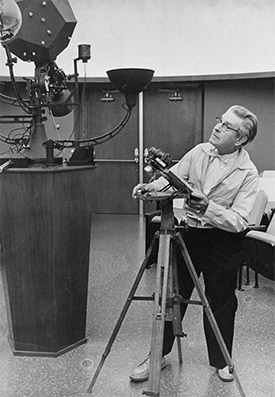
Hans Baldauf (1892-1965) is next to the new Spitz A2 projector at the Kalamazoo Public Museum.
A new public library/museum was being planned in the mid-1950s. In 1957, KAAA President Hans Baldauf persuaded Alexis Praus, Director of the Kalamazoo Public Museum, that a planetarium would be an excellent addition to the new building. Praus agreed and asked Baldauf if the association would be able to assist in raising funds for a planetarium in the facility. Through the association, $11,000 was raised. The Kalamazoo Foundation provided an additional $24,000 to complete the planetarium. The planetarium opened its doors to the public on May 23, 1959. For the first few years of operation, members of the KAAA provided volunteer lecturers for the planetarium’s public programs.
The first of three name changes for our group occurred during a meeting on February 20, 1960. The KAAA was generically known as the “Kalamazoo Astronomy Club” (KAC) for the remainder of the decade.
Toward the end of the 1960s, the membership of the group had grown older. Because meetings were held in members' homes, new members could become aware of the organization only by invitation or by reading who to contact in Sky & Telescope magazine. As new members entered the group, the close ties that existed between the original association members did not develop. The group was beginning to fray.
New, younger members entered the organization from time to time. Eventually, they took the torch from the original association. In the autumn of 1968, KAC Vice President Roger McPherson announced that the older members no longer wanted to continue meeting and that the future of the organization was in the hands of its younger members.
One of the first changes was making the club more accessible to new members. Meetings shifted from members' homes to the Adventure House at the Kalamazoo Nature Center. Following the meetings, members would view the night sky from the Adventure House parking lot. A constitution was drafted for the operation of the group, which was then called the Kalamazoo Amateur Astronomical Society (KAAS).
For a few years, the society met and observed at a clubhouse on E Avenue, provided by the Kalamazoo Nature Center. The clubhouse was set up with facilities for grinding telescope mirrors and overnight accommodations for observing. Unfortunately, the plumbing never worked properly, and the club members misused the facility. After a few years, it began to deteriorate.
Society members searched for a better meeting site. Mike Potter, then President of the KAAS, contacted Alexis Praus at the Public Museum. The society was welcomed to meet in the planetarium (now called the Hans Baldauf Planetarium after his death in November 1965). At the time, several members of the society learned to operate the museum’s new planetarium projector. Once again, the society provided volunteer support for public shows at the planetarium.
The society grew rapidly with the help of two astronomical events. Several members participated in an expedition to see a total eclipse of the Sun on March 7, 1970, from a football field in Alma, Georgia. At the meeting where members shared their results, Bill Nigg came to show the eclipse photographs he shot in North Carolina. The eclipse was one event. The other was the apparition of Comet Bennett. Several club members would drive in the early morning hours to an observatory Roger McPherson was building in his backyard. The comet provided several weeks of excitement, which strengthened the interest of many Society members. During this period, the club name was shortened to the Kalamazoo Astronomical Society, which we use today.
The growth phase lasted until 1976. At the August meeting, more than 90 members and visitors jammed their way into the planetarium to hear about the Viking space probe’s discoveries on the surface of Mars. Gradually, the society declined as core members aged past college years and sought employment. Some found work in their area of interest. Larry Mascotti graduated from Western Michigan University and went to work at a planetarium in Rochester, Minnesota. Jordan Marché went to the planetarium at Franklin and Marshall College in Lancaster, Pennsylvania. Mike Potter and Don Neill went to the University of Michigan and were later employed by the Space Telescope Science Institute in Baltimore, Maryland. Bob Dutilly moved away to work at the Goddard Space Flight Center in Greenbelt, Maryland. Other members moved on as well. Some went away to school, some moved for employment, and some lost interest as new hobbies claimed their spare time.
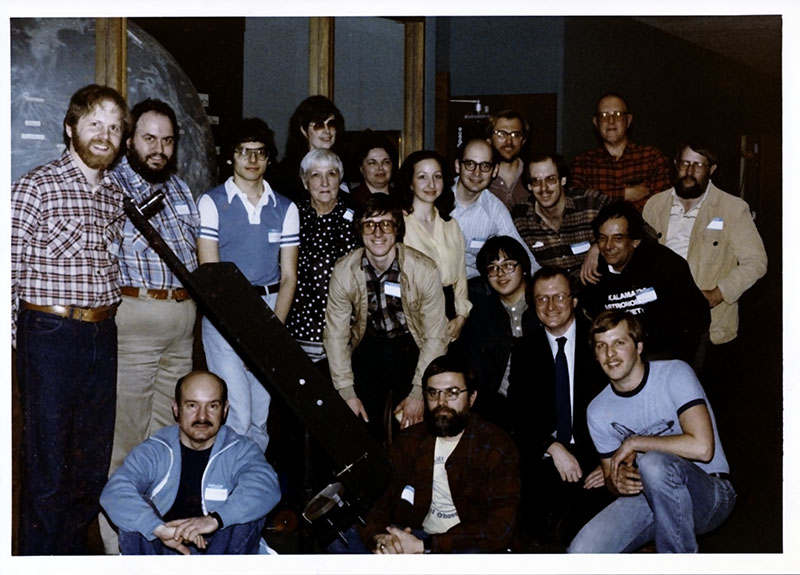
KAS members pose for a group photo outside the Hans Baldauf Planetarium after a general meeting in the spring of 1983.
Astronomical events in the early 1990s helped to start a new period of growth for the society. Many members watched the partial phases of the July 11, 1991, solar eclipse. Several members traveled to Baja California to view the totally eclipsed Sun. Three years later, an annular eclipse crossed Southwest Michigan. The whole society became part of a major observing program that included the Kalamazoo Area Mathematics & Science Center (KAMSC), the Kalamazoo Public Museum Planetarium, fifteen area high schools, and amateur radio operators. Mike Sinclair and Eric Schreur were named joint winners of the 1996 Hans Baldauf Award due to their work on the Northernmost Eclipse Graze Line Project.
Membership once again began to rise in the 60th year of the KAS. It also saw the end of an era. After 30+ years, the Society held its final meeting in the Hans Baldauf Planetarium at the Kalamazoo Public Museum on December 1, 1995. The museum closed its doors forever on December 23rd and reopened in a new building as the Kalamazoo Valley Museum in February 1996. The new KAS President, Mike Sinclair, moved us to the Presentation Center at the Kalamazoo Area Math & Science Center. We now had to find monthly guest speakers instead of relying on the planetarium for entertainment. This, along with increased publicity, resulted in a dramatic increase in meeting attendance. Many prominent members of the professional and amateur astronomical communities have given presentations at our monthly gatherings at KAMSC.
![[T. Dickinson]](images/history/dickinson.jpg)
Terence Dickinson
![[A. Dyer]](images/history/dyer.jpg)
Alan Dyer
![[J. K. Beatty]](images/history/beatty.jpg)
J. Kelly Beatty
That same year, the new KAS Board decided to pursue non-profit status. Work began on a new constitution and bylaws. At the same time, several members began drawing up plans for an observatory at the Kalamazoo Nature Center. Ground was broken on October 16, 1996. Owl Observatory was dedicated on August 22, 1998. The final version of the KAS Articles of Incorporation and Bylaws was finally approved by the KAS Board in February 1999. The KAS received incorporation status from the state of Michigan in April 1999.
Two bright comets also helped create a boom in membership. Comet Hyakutake graced the skies in March 1996. Many KAS members were featured in the local media. Over 600 people enjoyed the astronomical trifecta of a deep-partial lunar eclipse, Mars near opposition, and Comet Hale-Bopp on March 23, 1997. Hundreds more came out to the Nature Center for CometWatch in early April 1997.
A campaign to upgrade Owl Observatory began in 2000. Richard Bell led an effort to sell 1,000 pairs of eclipse glasses for the December 25th partial solar eclipse. Matt Borton and his father Gordon installed a new roll-off system for the roof and built a custom telescope pier. Equipment and materials for this project were purchased with a $3,700 donation from Consumers Concrete. Matt earned his Eagle Scout badge for his efforts. Over $3,300 was raised to purchase a 12-inch Schmidt-Cassegrain, which was installed on June 7, 2001.
Thousands of people observed the universe through the 12-inch SCT at Astronomy Day events between 2001 and 2004. An estimated 1,200 people observed Mars during its historic opposition on August 27, 2003. Hundreds of students from the local colleges and universities have used the 12-inch SCT to complete class projects. Dr. John Miller, from WMU, used the 12-inch to measure the speed of light from distant quasars.
One of the most significant accomplishments of the KAS took place in February 2004. The KAS was FINALLY granted 501(c)(3) non-profit status from the IRS. Several small donations and grants were soon given by members and corporations. This money was used to purchase materials to enhance our outreach and educational activities. It would also lead to several grants for high-profile Astronomy Day speakers and the major fund-raising campaigns that would follow in the years ahead.
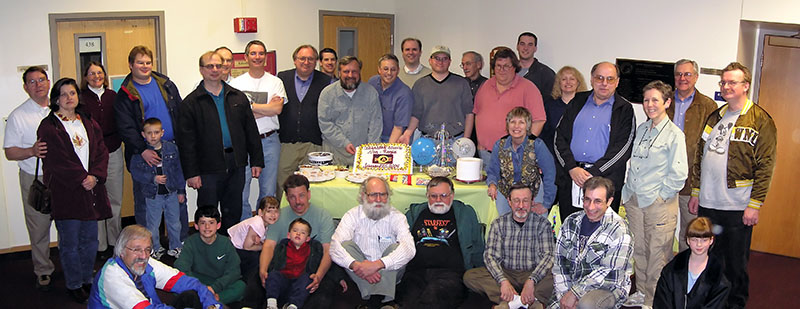
KAS members celebrate obtaining non-profit status on April 2, 2004.
KAS members invited the public to Warren Dunes State Park for two special astronomical events in May and June 2012. The partial solar eclipse on May 20th was mostly clouded out, but the eclipsed Sun became visible through a gap in the clouds shortly before setting. This took place during an intense but spectacular lightning storm that dazzled those that remained. Over 700 people (perhaps a thousand) returned to Warren Dunes on June 5th for the last Transit of Venus of our lifetime. Skies were crystal clear for the entirety of the transit, while being mostly clouded out further inland. Approximately 30 telescopes were set up to enjoy this rare planetary alignment.
The KAS received an amazing offer from member Mike Patton in January 2008: In return for technical advice and guidance with equipment for his new 20' × 20' roll-off roof observatory at Arizona Sky Village, near the small village of Portal, Mike would provide the KAS with space in that observatory for a telescope to be controlled remotely over the Internet. A strong majority of KAS members voted to begin the "Robotic Telescope Project" in December 2009. Our fund raiser, the largest in KAS history and led again by Richard Bell, began in September 2011 and officially concluded in November 2018. In all, over $122,000 was raised, the majority of which was through member contributions. KAS members made two group trips to install the Remote Telescope in December 2015 and March 2017. Members were at last able to reserve time on the telescope beginning in the spring of 2019. A special dedication ceremony was held on November 16, 2019 at Western Michigan University.
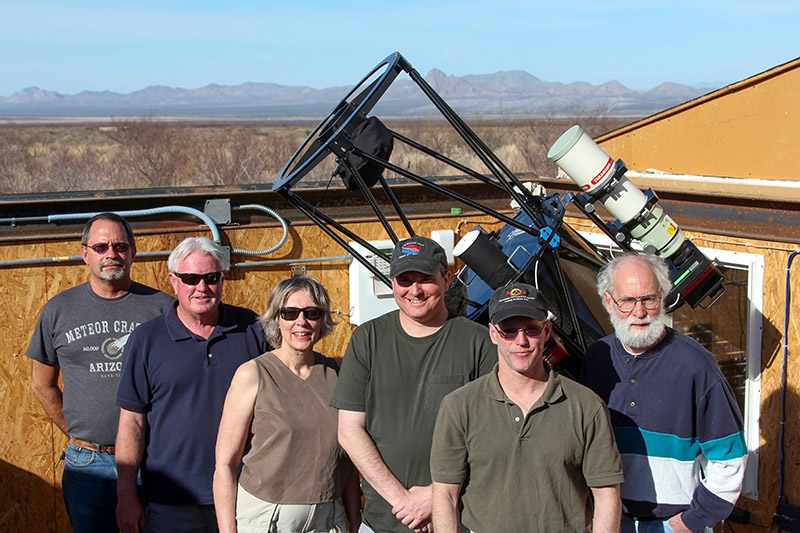
KAS members (from left to right) Jim Kurtz, Mike Patton, Jean De Mott, Richard Bell, Mike Cook, and Rich Mather pose with the Remote Telescope at Piishii Observatory on March 8, 2017.
After nearly 18 years, the 12-inch SCT in Owl Observatory was sold, and a second fund-raising campaign began, this time to seriously upgrade the facility. Thanks to the sale of eclipse shades for the August 2017 Great American Eclipse, donated telescopes, and generous contributions from members, over $41,000 was raised. A new pier, one that could support the weight of our new equipment, was constructed by KAS member Josh Taylor-Lehman. The initial equipment, a Meade 16-inch SCT and an Astro-Physics 1600GTO German equatorial mount, were installed on September 8, 2019. Additional equipment, including a Tele Vue 4-inch refractor and eyepieces, was added in 2020. Thanks to the efforts of the observatory’s original builder, Dave Garten, the roof was at last motorized, making the facility accessible to everyone. The new instrument was named the Leonard James Ashby Telescope, in honor of our founder and first president.
Many long-term goals still remain. We're considering starting an astronomy expo, similar to the Northeast Astronomy Forum in New York, sometime in the 2020s. It would be called the "Great Lakes Astronomy Super Show" (GLASS). We would still like to obtain a piece of dark-sky property. At first, this could be a place for members to go and observe, but eventually a larger observatory with a meeting space that could double as a classroom could be built there. We would also like to purchase a portable planetarium and increase our community outreach efforts. All these projects could be tied together in a comprehensive “Schoolyard Stargazer” program. These highly ambitious goals work toward the singular purpose of “promoting the exchange of information among those with a common interest in all areas of astronomy” and “to educate the public about astronomical discoveries and events.” The future is bright indeed.
The original version of this article was written by Eric Schreur and appeared in the June 1995 issue of "Prime Focus." Numerous revisions and updates were made by Richard Bell.